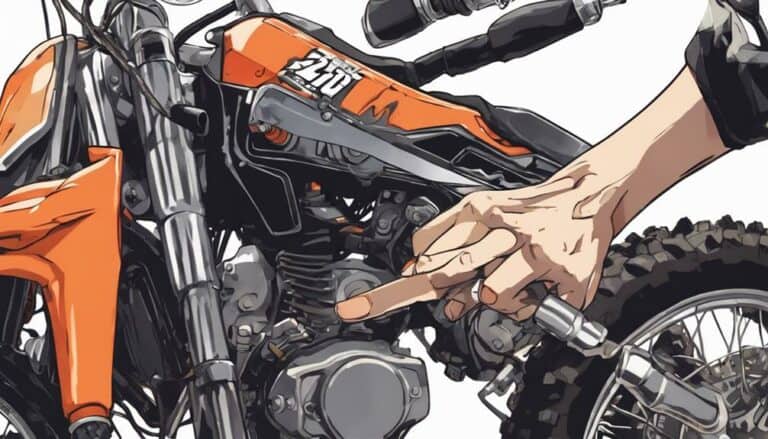If you're facing the frustrating feat of trying to get your wheels to release and roll on a 50cc dirt bike when the engine is off, the solution might be simpler than you think. Starting with some subtle shifts and gentle movements, you can potentially get those wheels unstuck and back in motion.
But what if these basic maneuvers don't do the trick? Well, there might be a more intricate issue at play that requires a closer look.
Stay tuned to uncover additional tips and tricks to troubleshoot this wheelie woe.
Key Takeaways
- Disengage clutch lever to unlock wheels for rolling.
- Ensure gear shift lever is in neutral position.
- Confirm transmission is disengaged for smooth movement.
- Verify proper wheel alignment and tire inflation before rolling.
Checking the Brake System
When inspecting the brake system of your 50cc dirt bike without an engine, begin by checking the brake calipers for any signs of sticking or binding. These issues could lead to the wheels locking up unexpectedly, compromising your safety.
Inspect the brake pads next, looking for wear or contamination that may be hindering their proper release. This step is critical to make sure that the brakes aren't engaged when they shouldn't be, causing unnecessary friction and potentially damaging the components.
Moving on, examine the brake lines meticulously for any kinks, leaks, or damage that could impede the smooth flow of brake fluid. It's essential to maintain a clear pathway for the brake fluid to travel, allowing for maximum braking performance.
If you encounter stubborn bolts or nuts during the inspection, a product like PB Blaster can help loosen them up for easier removal. By following these steps attentively, you'll have a thorough understanding of what's going on with your brake system and can address any issues promptly.
Releasing the Clutch Lever
To release and roll a 50cc dirt bike without an engine, the next step involves pulling the clutch lever towards the handlebar to disengage the clutch mechanism. By disengaging the clutch, you allow the wheels to spin freely without the engine's resistance, enabling movement. This process is important for rider safety as it prevents sudden jerks or stops when trying to move the bike manually. Proper clutch maintenance is important to guarantee smooth operation and longevity of the clutch system.
Engaging the clutch lever effectively puts the bike in a neutral state, preventing the transmission from locking the wheels. Once you have pulled the clutch lever and confirmed the bike is in neutral, gently push or roll the bike to test if the wheels are now unlocked and rolling freely. Releasing the clutch lever should allow the wheels to move smoothly and effortlessly when the engine is off. Understanding this fundamental aspect of motorcycle mechanics empowers you to control your bike even when the engine isn't running.
Adjusting the Gear Shift
Adjust the gear shift lever on the 50cc dirt bike to align with the neutral position, making sure the wheels can rotate freely.
- Gear shift alignment, troubleshooting:
Begin by locating the gear shift lever on the bike. Use the provided tools to adjust the lever until it aligns with the neutral position indicator.
- Neutral position, functionality:
Once the gear shift lever is aligned correctly, test the functionality by gently shifting it into neutral. Make sure that the neutral light indicator, if present, confirms the position.
- Transmission disengagement, troubleshooting:
With the bike in neutral, try to move it slightly to check if the transmission is fully disengaged. Any resistance or grinding noises may indicate a misalignment issue.
- Confirm before rolling:
Before attempting to roll the bike, double-check that the gear shift lever is in neutral. This step prevents potential transmission damage and allows for smooth wheel rotation without engine power.
Inspecting the Transmission
Inspect the transmission system of your 50cc dirt bike by checking the gear selector position and examining the chain or belt for any signs of damage or blockages. Guarantee the transmission is in neutral to allow the wheels to move freely. Look for any debris or obstructions that may be causing the wheels to lock. Additionally, consider checking the transmission fluid levels and condition for proper lubrication of moving parts.
| Transmission Maintenance | Troubleshooting Techniques |
|---|---|
| Check gear selector position | Inspect chain or belt for damage |
| Verify transmission is disengaged | Search for obstructions or blockages |
| Assess fluid levels and condition | Ensure proper lubrication |
| Guarantee transmission is in neutral | Maintain smooth gear shifting |
Rolling the Dirt Bike
Before attempting to roll the dirt bike, make sure it's securely positioned on a flat surface with the engine turned off and in neutral gear.
- Tire pressure: Confirm the tires are adequately inflated to reduce rolling resistance and improve maneuverability.
- Wheel alignment: Validate that the wheels are aligned properly to prevent unnecessary friction and ensure smooth rolling.
- Lubrication maintenance: Regularly lubricate the wheel bearings and axles to reduce friction and allow the wheels to roll freely.
- Obstruction check: Inspect the wheels for any physical obstructions or issues that may be impeding their ability to roll smoothly.
Conclusion
After following these steps to release and roll the wheels on your 50cc dirt bike, you should be ready to hit the trails with ease. Remember to always check your brakes, clutch lever, gear shift, and transmission for any issues that may be causing the wheels to seize.
With proper maintenance and care, your dirt bike will be ready for any adventure that comes your way. Stay tuned for more tips and tricks to keep your ride running smoothly.

